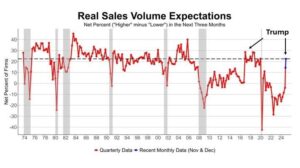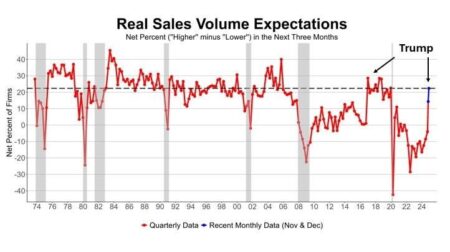Art Malkov is a Columbia University Blockchain Accelerator Advisor. Former CMO for leading Web3 companies.
I expect this year to be full of Web3 innovations and adoption, and from my view as a blockchain advisor, I want to take a look at what I believe could be possible for the “internet of money” in 2025. The arrival of new market participants, an influx of Web3 developers and a sea change in the regulatory landscape could spark the Web3 renaissance many have been waiting for.
The digital asset market saw growing interest in 2024, which has huge implications for Web3, the next generation of internet applications built on blockchain networks.
1. More favorable regulations could mean more transparent innovation.
A history of enforcement actions from the U.S. Securities and Exchange Commission toward much of crypto in the U.S. has had a chilling effect on development in Web3. High-profile cases such as the lawsuit against Ripple Labs over its XRP classification as a security; legal challenges faced by Coinbase, the largest centralized exchange in the U.S., for allegedly failing to register as a securities exchange; and investigations into the decentralized application Uniswap highlight the uncertainty and regulatory risks that have pushed some projects to seek friendlier jurisdictions abroad.
However, in 2025, some are anticipating a more crypto-friendly SEC, and more than 250 pro-crypto members of Congress were elected in November. President-elect Donald Trump has also been a vocal crypto supporter. Should there be policy changes that establish a clearer framework for crypto, I expect to see an unprecedented cascade of change for Web3, and Web3 projects may be able to reach bigger audiences through key opinion leaders.
2. Using alternative payment options could become increasingly easier.
In December, Coinbase added Apple Pay to its payment options. This move opens Web3 adoption to around 60 million Apple Pay users. As friction eases both ways between tokens and fiat, 2025 might be the year more businesses and consumers begin opting for cryptographic transactions over swiping plastic.
3. AI agents will help solve inefficiencies across verticals.
Large language models have become integral parts of doing business, and their presence will continue to solve inefficiencies across the board. The assistance of AI will undoubtedly become invaluable in advancing technology and the marketing that unites new tech with users throughout 2025.
Web3 relies heavily on code, and AI-assisted development tools could significantly accelerate the time to market for countless Web3 projects, particularly those led by smaller teams. Additionally, I believe AI will play a valuable role in elevating standout projects by helping identify the most effective channels for building brand awareness.
In a decentralized and complex ecosystem like Web3, AI’s ability to connect projects with the right influencers and audiences could be transformative, helping the best ideas gain greater visibility. I believe the year 2025 is poised to usher in an era of improved due diligence, where legitimate projects receive greater recognition and the scams of the past have fewer opportunities to thrive.
4. DePIN projects go mainstream with consumers and collaborations.
I expect decentralized physical infrastructure networks, known as DePINs, to reach mainstream adoption in 2025, driven by consumer-facing applications and collaborative initiatives. DePIN solutions are gaining speed on their Web2 counterparts.
Helium, for example, has paved the way with its decentralized wireless network, and projects like Hivemapper and IoTeX are expanding the concept to mapping, navigation and more. In 2025, we’ll likely see more DePIN projects collaborating with traditional industries, creating hybrid ecosystems that combine blockchain incentives with existing physical infrastructure.
This convergence will likely make DePIN projects more appealing to both consumers and businesses, pushing the boundaries of what’s possible in Web3.
5. More real-world assets see tokenization.
I’m also anticipating the tokenization of real-world assets like real estate, commodities and even intellectual property to accelerate in 2025. Blockchain technology and tokenization can make it easier to fractionalize ownership through RWAs, which can improve liquidity and lower barriers to participation in traditionally illiquid markets.
For example, tokenized real estate can allow investors to purchase fractional shares of high-value properties, democratizing access to lucrative markets. In addition, tokenized commodities like gold, sports team ownership or carbon credits could become widely traded on Web3 rails, which would create new opportunities for both investors and businesses seeking exposure to exotic assets.
I believe RWAs are primed to become one of the most significant growth areas in Web3, bridging traditional finance and blockchain innovation. By modernizing processes such as record-keeping, deeds and asset management with 21st-century technology, RWAs could unlock trillions of dollars in underlying assets and bring unprecedented value to the Web3 ecosystem.
Bullish On 2025: Looking Forward To Web3’s Future
One of the most significant developments shaping the future of Web3 is a potential regulatory shift. If regulatory roadblocks are addressed and we see a more favorable stance from the government and regulators, Web3 is poised to develop more rapidly and comprehensively than ever before in 2025.
Leaders in the Web3 industry should focus on seizing opportunities that could arise this year. To thrive in this evolving landscape:
• Embrace collaboration and education. Work closely with regulators, traditional industries and key stakeholders to build trust and establish robust, compliant frameworks that encourage participation. Educate your users and community about the benefits of Web3 to help remove barriers to entry.
• Leverage AI and data. Consider incorporating AI-driven tools into your operations to streamline development, enhance marketing strategies and identify the best opportunities for growth. Use data analytics to make informed decisions and connect with the right audiences.
• Innovate for real-world utility. Focus on solving real-world problems through tokenization, DePINs and other cutting-edge technologies. Build products that deliver tangible value, whether through fractional ownership, improved logistics or decentralized services.
As I see it, the Web3 ecosystem could be positioned for unprecedented growth in 2025, but success will require strategic planning, bold execution and relentless user focus. Leaders who innovate with transparency and scalability in mind will set the standard for the next era of the internet. Don’t wait for the future to unfold—shape it.
Forbes Business Council is the foremost growth and networking organization for business owners and leaders. Do I qualify?
Read the full article here











